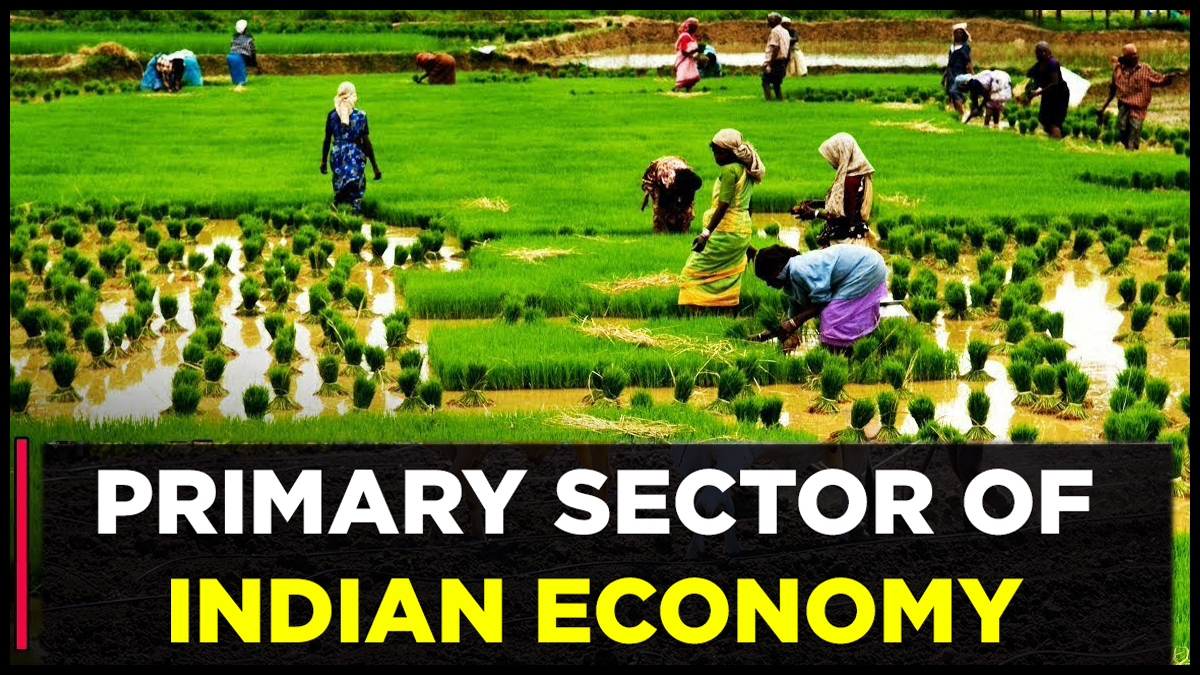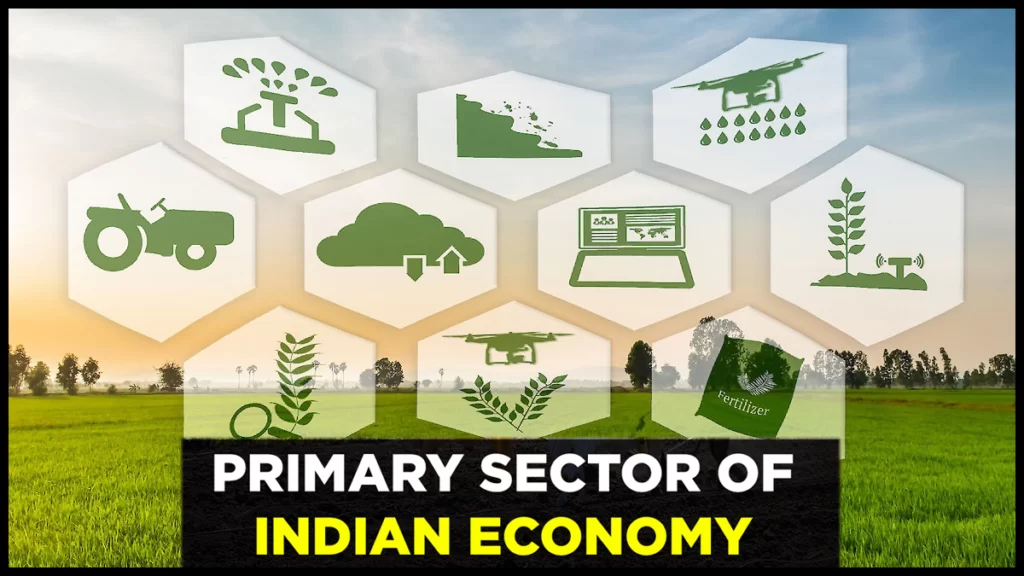
Indian Agriculture Sector: The agriculture sector in India is one of the most important contributors to the country’s economy. It employs about 50% of the workforce and contributes to 17-18% of India’s gross domestic product (GDP). The sector has undergone significant changes over the years, driven by the Green Revolution of the 1960s, which introduced high-yielding crop varieties, improved irrigation systems, and increased use of fertilizers and pesticides.

India is known for its diverse agricultural practices and produces a wide range of crops, including rice, wheat, pulses, oilseeds, cotton, sugarcane, fruits, and vegetables. The country is the world’s largest producer of milk, pulses, and spices, and the second-largest producer of wheat, rice, and fruits.
The agriculture sector in India faces various challenges
The agriculture sector in India faces various challenges, including land fragmentation, inadequate infrastructure, and low productivity. Small and marginal farmers, who constitute a significant portion of the farming community, often lack access to credit, technology, and modern farming practices, which hinders their ability to increase productivity and earn higher incomes.
The Indian government has implemented various policies and initiatives to address these challenges, including investments in infrastructure, irrigation, and rural electrification, and the promotion of sustainable agriculture practices. Additionally, the government has introduced schemes such as the Pradhan Mantri Fasal Bima Yojana, which provides insurance coverage to farmers against crop losses due to natural calamities.
A vital component of the country’s economy
Overall, the agriculture sector in India is a vital component of the country’s economy, and there is significant potential for growth and development in the coming years.
To further expand on the Indian agriculture sector, it’s worth noting that the sector also faces challenges related to climate change, water scarcity, and soil degradation. Climate change has led to unpredictable weather patterns, including droughts and floods, which can have a significant impact on crop yields. Water scarcity is a major concern in many parts of the country, particularly in regions that rely on groundwater for irrigation. Soil degradation is also a significant problem in many areas, caused by overuse, poor irrigation practices, and deforestation.
The Indian government has launched several initiatives
To address these challenges, the Indian government has launched several initiatives, including the National Mission for Sustainable Agriculture and the National Mission on Agricultural Extension and Technology. These programs aim to promote sustainable agriculture practices, including conservation of water resources, soil health management, and climate-resilient farming.
In recent years, there has also been a growing interest in organic farming in India. Organic farming is an agricultural practice that avoids the use of synthetic fertilizers and pesticides and relies on natural inputs such as compost and manure. India is one of the largest producers of organic food in the world, with over 1.5 million hectares of organic farmland.
The Indian agriculture sector also plays a crucial role in food security
The Indian agriculture sector also plays a crucial role in food security, as it provides essential food items to the population. The government has implemented several schemes to ensure that food reaches the poorest and most vulnerable sections of society, including the National Food Security Act and the Mid-Day Meal Scheme for school children.
In conclusion, the Indian agriculture sector is a significant contributor to the country’s economy, and there is considerable potential for growth and development. However, to realize this potential, the sector must address its challenges and embrace sustainable farming practices.
Another aspect
Another aspect of the Indian agriculture sector is the role of technology in modernizing farming practices. With the growing population and demand for food, there is an increasing need to improve crop yields and efficiency in agriculture. The Indian government has launched several programs to promote the use of technology in farming, such as the National e-Governance Plan for Agriculture and the Krishi Vigyan Kendra program.
One of the key technologies that have transformed Indian agriculture is the use of mobile phones and internet-based platforms for disseminating information and providing access to markets. Several apps and websites have been developed to help farmers connect with buyers, access information on crop prices, weather forecasts, and farming techniques. This has enabled farmers to make informed decisions and get fair prices for their crops.
The Indian agriculture sector also presents several opportunities for entrepreneurship
The Indian agriculture sector also presents several opportunities for entrepreneurship and innovation. Startups are developing new solutions to address challenges faced by farmers, such as crop monitoring and management tools, precision agriculture, and agri-finance platforms.
Furthermore, the agriculture sector has the potential to play a significant role in India’s goal of becoming a $5 trillion economy. The government has identified agriculture as one of the key sectors that could drive economic growth, and there is a renewed focus on increasing investment in the sector, particularly in areas such as food processing, logistics, and infrastructure.
A dynamic and evolving sector
In conclusion, the Indian agriculture sector is a dynamic and evolving sector that presents significant opportunities for growth and development. The sector faces several challenges, but with the right policies and initiatives. And there is significant potential to improve productivity, promote sustainability, and drive economic growth.
Another important aspect of the Indian agriculture sector is the role of women in agriculture. Women make up a significant portion of the agricultural workforce in India. Also with estimates suggesting that women comprise about 70% of the labor force in the sector. However, despite their contribution, women face several challenges, including limited access to resources such as credit, land, and technology. To address these challenges. Also the government has implemented several programs and initiatives to promote the participation of women in agriculture. Also including the Mahila Kisan Sashaktikaran Pariyojana and the National Rural Livelihood Mission.
Contributor to environmental sustainability
Additionally, the Indian agriculture sector is also a significant contributor to environmental sustainability. The sector is responsible for about 18% of India’s greenhouse gas emissions, primarily from livestock and rice cultivation. However, there are several initiatives to promote sustainable agriculture practices, including organic farming, conservation agriculture, and climate-smart agriculture. These practices can help reduce the carbon footprint of agriculture and promote environmental sustainability.
Finally, the Indian agriculture sector has a significant impact on rural livelihoods. Agriculture provides employment and income opportunities to millions of people in rural areas. And the sector’s growth has a positive multiplier effect on other sectors, including food processing, transportation, and logistics. However, the sector also faces several challenges, including rural poverty and migration. To address these challenges, the government has implemented several programs. And initiatives to promote rural development and improve the quality of life of people living in rural areas.
The Indian agriculture sector is a complex
In conclusion, the Indian agriculture sector is a complex. And multifaceted sector that plays a significant role in the country’s economy, environment, and society. The sector presents several opportunities for growth and development, but it also faces several challenges. Addressing these challenges will require a coordinated effort from the government, private sector. And civil society to promote sustainable agriculture practices, improve access to resources, and promote rural development.
Another important aspect of the Indian agriculture sector is the role of agricultural exports. The country is one of the largest exporters of agricultural products in the world, including rice, wheat, sugar, and cotton. The government has implemented several policies to promote agricultural exports. Also including the Agricultural and Processed Food Products Export Development Authority and the Export Inspection Council. These policies have helped promote the export of high-value agricultural products. And have contributed significantly to the country’s foreign exchange earnings.
Also vulnerable to pests and diseases
Moreover, the Indian agriculture sector is also vulnerable to pests and diseases. Also which can cause significant damage to crops and affect food security. To address this challenge, the government has implemented several programs to control pests and diseases. Also including the National Plant Protection Programme and the National Centre for Integrated Pest Management.
Finally, the Indian agriculture sector also faces challenges related to land ownership and land use. The country’s land tenure system is complex, and small farmers often face difficulties in accessing land and securing tenure rights. The government has implemented several initiatives to promote land reform. Also including the Land Acquisition, Rehabilitation and Resettlement Act and the Pradhan Mantri Fasal Bima Yojana. These initiatives aim to improve land tenure security for small farmers and promote sustainable land use practices.
Plays a significant role in the country’s economy
In conclusion, the Indian agriculture sector is a vital sector that plays a significant role in the country’s economy. Environment, and society. While the sector faces several challenges, including climate change, water scarcity. And land ownership issues, there are several initiatives to promote sustainable agriculture practices. Also improve access to resources, and promote rural development. Addressing these challenges will require a coordinated effort from the government. Private sector, and civil society to ensure the sector’s growth and development.
Another significant aspect
Another significant aspect of the Indian agriculture sector is the role of the cooperative movement. Cooperatives are organizations owned and operated by the members. And they play a crucial role in promoting the interests of farmers, especially small and marginal farmers. In India, cooperatives are prevalent in several areas, including milk, sugar, and cotton. These cooperatives provide farmers with access to credit, markets, and technology. And they help improve the livelihoods of farmers and their families.
Additionally, the Indian agriculture sector is also impacted by climate change. The sector is highly vulnerable to climate change, which can result in crop failure, reduced productivity, and loss of livelihoods. To address this challenge, the government has implemented several initiatives to promote climate-smart agriculture practice. Also including the National Mission for Sustainable Agriculture and the National Adaptation Fund for Climate Change.
Moreover, the Indian agriculture sector is also impacted by the ongoing COVID-19 pandemic. The pandemic has disrupted supply chains, caused labor shortages, and affected the demand for agricultural products. To address these challenges, the government has implemented several measures. Also including providing financial support to farmers, ensuring the availability of agricultural inputs. And promoting e-commerce platforms for agricultural products.
Finally, the Indian agriculture sector is also impacted by the changing dietary habits of consumers. With increasing incomes and urbanization, there is a growing demand for high-value agricultural products, including fruits, vegetables, and meat. This shift in demand presents several opportunities for farmers to diversify their crops and improve their incomes.
Also Read – All about Hindu Nav Varsh 2023
In conclusion
In conclusion, the Indian agriculture sector is a complex and dynamic sector that plays a significant role in the country’s economy. Environment, and society. The sector faces several challenges, including climate change, the COVID-19 pandemic. And changing dietary habits, but there are several initiatives to promote sustainable agriculture practices, improve access to resources. And promote rural development. Addressing these challenges will require a coordinated effort from the government, private sector. And civil society to ensure the sector’s growth and development.
Also Read – All about Down Syndrome

2 thoughts on “All about Indian Agriculture Sector”